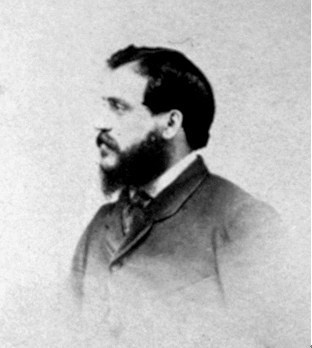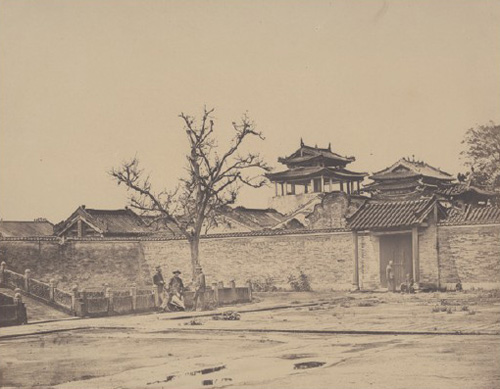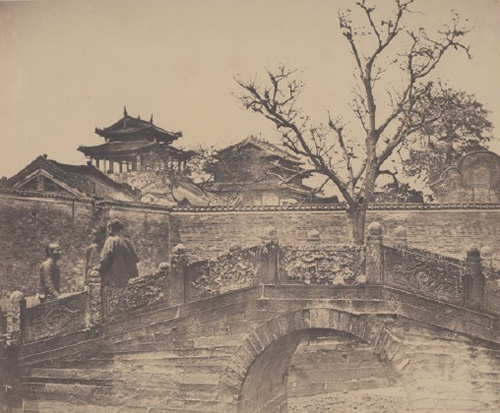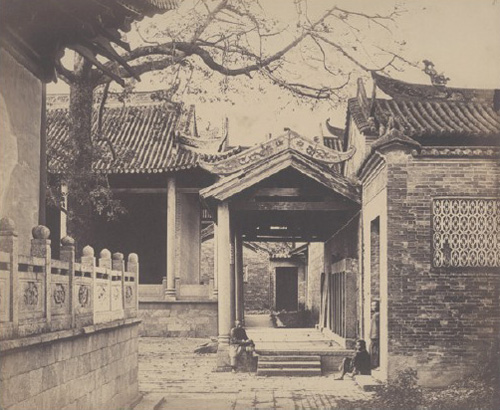|
Introduction of the artist:

Felice BEATO (Italy)
Born in 1832, Venice, Italy. Died in 1909, Florence, Italy. Photographer.
Introduction of works:

Five Genii Temple, Canton, April 1860
albumen silver print from a wet
collodion glass negative
The figure with the umbrella at the centre of the
image is the English artist Charles Wirgman (1832-1891)who
worked for the
Illustrated London News. He worked closely with Beato in China and some of his
illustrations
are derived from Beato's photographs.

Bridge in Temple of Five Genii, Canton, April 1860
albumen silver print
from a wet collodion glass negative
This Taoist temple - also called the
Temple of the Five Immortals - was built in 1377. In Cantonese it is called
Wuxian Guan. The name refers to the famous story about the origins of Canton
/ Guangzhou in which the
Five Celestial Beings came to the city riding on
five celestial rams and brought rice and the knowledge of rice
cultivation
to the people as a means of avoiding the scourge of famine. The Five Genii
Temple is situated in
Huifu Rd., just west of Jiefang Zhonglu,
Guangzhou.

Gallery in Confucius Temple, Canton, April 1860
albumen silver print from
a wet collodion glass negative
This temple formed part of the College of the
Nanhai District, Hio Kung, and was located close to the Temple of the Five Genii
in the Tartar Quarter.
The earliest vision of Imperial China in Europe was shaped by the late
13th-century travelogue, commonly known as the Travels of Marco Polo, or
nicknamed Il Milione (the Million). This book was dictated by the Venetian
merchant Marco Polo in 1298 and it describes his travels to China between 1271
and 1291. China would only become ‘visible’ to most people in the West after the
invention of photography in 1839. As the semi-official photographer of the
Anglo-French North China Expeditionary Force, Felice Beato came to China in the
mid nineteen century. During a few months stay in Canton (Guangdong), he made
approximately one hundred large plate photographic images (10 by 12 inches) of
the city of Guangzhou. Principally surviving in the form of private albums,
these are the earliest known photographs of China.
In the past thirty or more years, China has witnessed extraordinary
developments in both scale and depth. As Chairman Mao once taught, ‘no
construction without destruction’, which seems to be not only an oath for his
Cultural Revolution (1966-76) to China nearly half of a century ago, but also as
a prophecy of today’s urban developments. Constructions in China are not merely
efforts of improvement, but indeed an act of revolution, to fundamentally
replace the ‘old’ with an entirely ‘new’ visual experience. Buildings,
architectural complexes, streets and even a whole city can be transformed from
one physicality to another offering little trace of what has gone on before.
Envisaging all these transformations in China that engender both excitement
and anxiety, ‘revolutionary’ urbanisation has proved one of the most inspiring
and successful topics in contemporary photography. Here, this series of
documentary photographs of the Qing dynasty offers an extreme example of the
unseen past, or indeed, an opportunity to travel together with Beato and Polo,
to a remote and admiring kingdom, or a somehow alienated
homeland. | 
